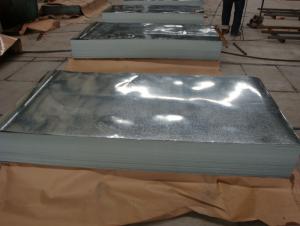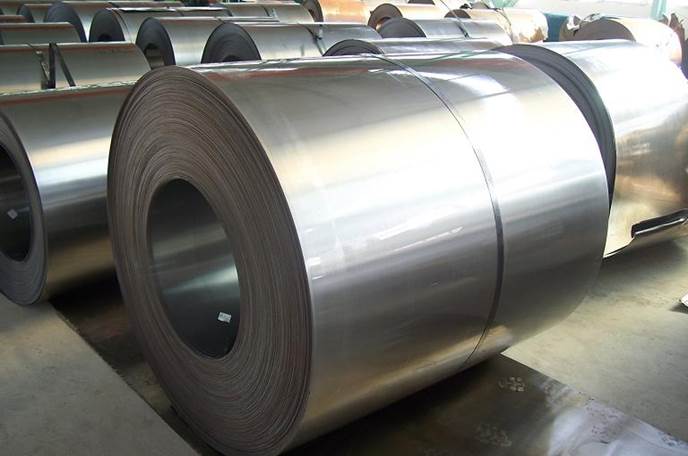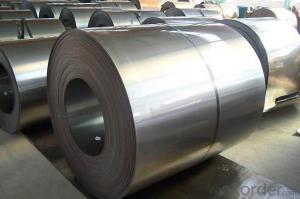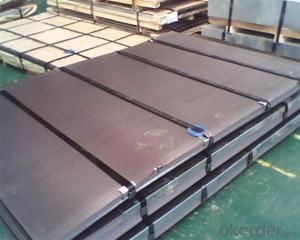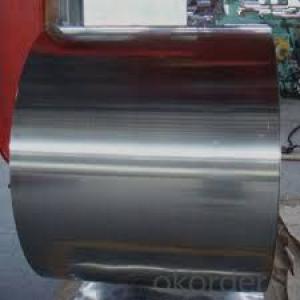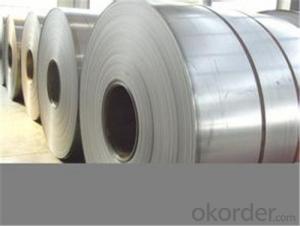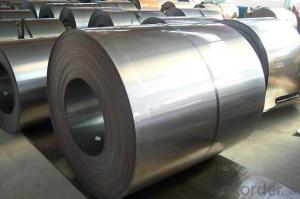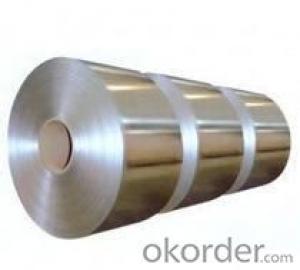Cold Rolled Steel Coils/Sheets, Top Mill's Resource from China, CNBM
- Loading Port:
- China main port
- Payment Terms:
- TT OR LC
- Min Order Qty:
- 25 m.t.
- Supply Capability:
- 100000 m.t./month
OKorder Service Pledge
OKorder Financial Service
You Might Also Like
Product Name | Cold Rolled Sheet Coil |
Material | SPCC/SPCD/SPCE/DC01/ST12/ ST14/SPCD/DC03/DC04 ect. |
Grade Standard | JIS G3302, EN10142, ASTM653, ASTM95 |
Thickness | 0.15-3.5mm |
Width | 600mm-1500mm |
Coil ID | 508-610mm |
Coil OD | max 1500mm |
Weight | 3-10 Tons |
Tolerance | Thickness tolerance:+/-0.02mm; Width tolerance:+/-5mm |
Surface | No-skin passed or Skin passed, Tensile leveled |
Surface Treatment | Chromate/Unchromate passivation, fingerprint resistant treatment, oiled/unoiled |
Annual Output | 350,000MT |
Application | Construction, hardware, home applicances, interior decoration |
Classification | Designation | Characteristics | Main applications |
Commercial quality | SPCC SPCCT | Commercial quality suitable for bending fabrication and simple forming; this is the type in greatest demand. | Refrigerators, cabinets, power distribution baords and drums. |
Drawing quality | SPCD | Drawing quality second only to that of SPCEN. Excellent uniformity. | Automobile floor and roof panels. |
Deep-drawing quality | SPCE SPCF | Deep-drawing quality.With metallurgically controlled grain size, it retains its beautiful finish even after being deep-drawn. | Automobile fenders and quarter panels |
Extra deep-drawing quality | SPCG | Extra-low-carbon steel sheets with highest workability | Automobile internal panels and deep-drawn parts |
- Q: What are the common applications of hot-dip galvanized steel coils?
- Hot-dip galvanized steel coils have a wide range of applications due to their excellent corrosion resistance and durability. Some of the common applications of hot-dip galvanized steel coils include: 1. Construction: Hot-dip galvanized steel coils are extensively used in the construction industry for various applications such as roofing, siding, gutters, and downspouts. The corrosion resistance of these coils makes them ideal for withstanding harsh weather conditions, ensuring long-lasting and low-maintenance structures. 2. Automotive: Hot-dip galvanized steel coils are widely used in the automotive industry for manufacturing parts like body panels, frames, chassis, and structural components. The corrosion resistance and high strength of these coils provide enhanced protection against rust and ensure the longevity of automotive parts. 3. Appliances: Hot-dip galvanized steel coils find applications in the manufacturing of various household appliances such as refrigerators, air conditioners, ovens, and washing machines. The corrosion resistance and aesthetic appeal of galvanized steel make it an ideal choice for these appliances. 4. Agriculture: Hot-dip galvanized steel coils are commonly used in the agricultural sector for building greenhouses, livestock shelters, fences, and irrigation systems. The galvanized coating protects the steel from corrosion caused by exposure to moisture and chemicals commonly found in agricultural settings. 5. Electrical and Telecommunication: Hot-dip galvanized steel coils are utilized in the electrical and telecommunication industries for the production of transmission towers, poles, cable trays, and electrical conduits. The corrosion resistance and high strength of galvanized steel ensure the safety and reliability of these infrastructure components. 6. Transportation: Hot-dip galvanized steel coils are extensively used in the transportation industry for manufacturing trailers, shipping containers, and chassis components. The galvanized coating provides protection against corrosion caused by exposure to road salt, moisture, and various environmental factors. 7. Industrial Applications: Hot-dip galvanized steel coils are employed in various industrial applications such as storage tanks, pipelines, ductwork, and industrial equipment. The corrosion resistance and durability of galvanized steel ensure the integrity and longevity of these structures and equipment. In summary, the common applications of hot-dip galvanized steel coils encompass a wide range of industries, including construction, automotive, appliances, agriculture, electrical and telecommunication, transportation, and industrial sectors. The corrosion resistance, durability, and aesthetic appeal of galvanized steel make it a versatile and widely used material in these applications.
- Q: I have a set of Ben Hogan Apex Plus Forged Irons, how can i figure out if the shafts are steel or graphite?
- Most steel shafts are stepped, meaning there will be a series of ridges that run down the lengeth of the shaft every few inches. Also, take a piece of metal and tap the shaft with it. If it makes a ping type of sound, its metal. If it makes a clunk sound, its graphite. Or, look out the window and ask the first person you see walking by. Unless they are younger that 10 years old, they should be able to tell you pretty easily.
- Q: Can steel coils be coated with phosphorescent materials?
- Yes, steel coils can be coated with phosphorescent materials. The phosphorescent coating can be applied to the surface of the steel coils, allowing them to emit a glow in the dark or low-light conditions.
- Q: Are steel coils recyclable?
- Yes, steel coils are recyclable. Steel is a highly recyclable material that can be melted down and used to create new steel products, including steel coils. Recycling steel coils helps to conserve natural resources, reduce energy consumption, and minimize waste.
- Q: what is the history of steel and how did they start making it, i need a link or an answer that is five paragraphs long. plus i need examples of subtitles about the history of steel. i am doing this for a science project and hope that someone can help me out.thanks
- There's wide history of steel, you can read different tutorials online to know more about it. Check wiki for detailed information.
- Q: What are the common storage defects in steel coils?
- Steel coils can suffer from various storage defects, including staining or discoloration, rust or corrosion, coil deformation, surface damage, edge damage, coil slippage, contamination, and coil nesting. These defects can negatively impact the appearance, quality, usability, and safety of the steel. To prevent these defects, it is essential to implement proper handling, storage, and protection measures. This involves storing the steel coils in a dry and well-ventilated area, away from moisture and chemicals. Additionally, appropriate stacking and support structures should be used to prevent deformation and bending. To avoid mishandling and transport damage, it is important to stack and handle the coils correctly. Adequate protection against impacts and contaminants should be provided to prevent surface scratches, dents, and abrasions, as well as edge damage. It is crucial to ensure that the edges of the coils are properly protected and secured during storage to maintain their usability and safety. Furthermore, to prevent coil slippage and potential harm to personnel or equipment, the steel coils should be securely stored and stacked. To avoid contamination, the coils should be kept away from substances like dirt, oil, grease, and chemicals. Regular inspections and maintenance should be conducted to identify and address any potential defects or issues promptly. Overall, by implementing these proper handling, storage, and protection measures, the occurrence of these common storage defects in steel coils can be minimized, ensuring the appearance, quality, usability, and safety of the steel.
- Q: How are steel coils used in the production of electrical switches?
- Steel coils are used in the production of electrical switches as the core component of electromagnetic relays. When an electric current passes through the coil, it generates a magnetic field which attracts or repels a metal armature, thus opening or closing the electrical circuit. This mechanism allows electrical switches to control the flow of electricity in various applications.
- Q: How are steel coils processed for galvanizing or coating?
- Steel coils are processed for galvanizing or coating through a series of steps. First, the coils are cleaned to remove any dirt, grease, or other contaminants. Then, they are dipped into a bath of molten zinc or coated with a protective layer using various methods such as electroplating or hot-dip coating. After the coating process, the coils may undergo further treatments like drying, cooling, and leveling to ensure uniformity and quality.
- Q: How are steel coils used in the manufacturing of solar panels?
- Steel coils are used in the manufacturing of solar panels primarily for the structural support and durability they provide. These coils are often used to construct the frames and mounting systems that hold the solar panels in place. The strength of steel ensures that the panels remain stable and secure, even in harsh weather conditions. Additionally, steel coils can be shaped and formed to meet the specific design requirements of solar panel installations, making them a crucial component in the manufacturing process.
- Q: i am working a client.my vendor specified in pipe specification pipe line class as MS1 (code for Mild steel)but assigned material to this code is cs smls astm A 106B.my question is any difference between CS and MS material?pls suggest me
- *Carbon steel, also called plain carbon steel or Mild Steel, is steel where the main alloying constituent is carbon. The AISI defines carbon steel as: Steel is considered to be carbon steel when no minimum content is specified or required for chromium, cobalt, columbium, molybdenum, nickel, titanium, tungsten, vanadium or zirconium, or any other element to be added to obtain a desired alloying effect; when the specified minimum for copper does not exceed 0.40 percent; or when the maximum content specified for any of the following elements does not exceed the percentages noted: manganese 1.65, silicon 0.60, copper 0.60. If it crosses limit as said, it will come under alloy steel. ASTM A 106 gr B is a carbon steel pipe and seamless Pipe for High Temperature Service. So, it will be a mild steel comes under carbon steel category.
Send your message to us
Cold Rolled Steel Coils/Sheets, Top Mill's Resource from China, CNBM
- Loading Port:
- China main port
- Payment Terms:
- TT OR LC
- Min Order Qty:
- 25 m.t.
- Supply Capability:
- 100000 m.t./month
OKorder Service Pledge
OKorder Financial Service
Similar products
Hot products
Hot Searches
Related keywords
